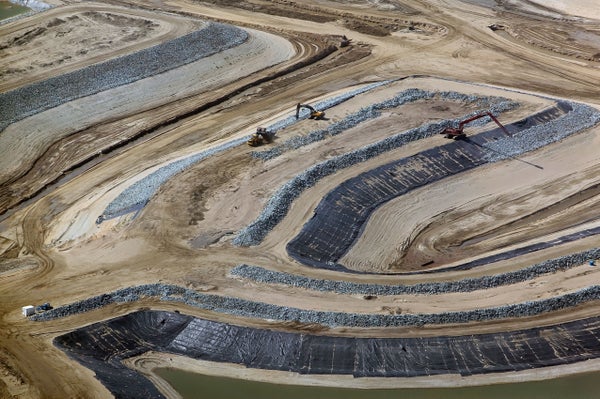As rising seas encroach on coastal communities, governments and property owners often try to block the water by setting up barriers such as seawalls or levees. But a new study has found this conventional fix can seriously backfire in bays and estuaries, potentially causing worse flooding and massive economic damage in nearby unprotected communities. The research, published in July in Proceedings of the National Academy of Sciences USA, focused on San Francisco Bay, the largest estuary on the West Coast—and the findings could also apply to other major cities, from London to Hong Kong.
According to the paper, bays and estuaries account for about one fifth of the world’s coastal shorelines, but such areas are home to nearly 500 million people. This is more than half of the global population believed to be at risk for flooding caused by sea-level rise. Other large cities on bays and estuaries include New York, Calcutta and Buenos Aires.
The partially enclosed nature of estuaries and bays means floodwaters have limited room to spread when they hit a barrier. “If you protect an open part of the coast, water can go lots of places,” says Ming Li, a physical oceanographer at the University of Maryland’s Horn Point Laboratory on Chesapeake Bay, the largest estuary in the U.S. “But estuaries are enclosed, with one connection to the ocean. If you protect part of an estuary with a seawall, water has to go somewhere else in the estuary.”
On supporting science journalism
If you're enjoying this article, consider supporting our award-winning journalism by subscribing. By purchasing a subscription you are helping to ensure the future of impactful stories about the discoveries and ideas shaping our world today.
San Francisco Bay’s shoreline runs for about 1,000 miles, and the new study’s lead author Michelle Hummel and her colleagues divided it into 30 sections according to its geography. The sections ranged from steep, rocky headlands and bluffs to wide, low-lying alluvial valleys where rivers flow into the bay. The researchers used computer models to examine how a seawall along each section would affect future flooding in the rest of the bay, factoring in sea-level rise during the highest tides of the year.
Hummel and the other researchers found that seawalls in one section could increase flooding in another, even at considerable distances from the barriers themselves. Notably, a seawall along the southern tip of the bay near San Jose would increase flooding in the northern tip near Napa, Calif.—a city about 60 miles away. “It really surprised us that impacts can extend all the way across the bay and from the south to the north end,” says Hummel, a civil engineer at the University of Texas at Arlington.
This kind of unintended consequence is most pronounced in wide alluvial valleys, which, when left in their natural state, protect against floods by slowing down potentially damaging waves as well as storing floodwaters. Seawalls along the alluvial valleys can negate the natural benefits these low-lying areas confer to unprotected sections.
California’s sea level is projected to rise by as much as seven feet by 2100, according to the state’s Legislative Analyst’s Office. Hummel and her colleagues found that at about 6.5 feet of sea-level rise and during a single high tide, a seawall along San Jose’s alluvial valley would increase flooding by 36 million cubic meters (1.27 billion cubic feet) and raise damage costs by $723 million in the rest of the bay.
An alternative to seawalls is allowing inundation in selected low-lying parts of the bay, a tactic the researchers call “strategic flooding.” The team assessed this natural solution with regard to Highway 37, a key traffic artery that runs between the north shore of the bay and tidal marshes, and that already floods during intense rainstorms and ultrahigh tides. The researchers compared the scenario of elevating the highway on a causeway, which would allow incoming tides to pass under the road and flood the marshes, with the approach of building it on a levee, which would effectively act as a seawall. They found that “building the levee would flood communities all around the bay and increase [overall] damages for a single high tide by $293 million,” Hummel says. In that case, the damage to other areas would outweigh that avoided in the protected section.
Documenting the economic impact of individual seawalls could help promote the work of Bay Adapt, a San Francisco Bay Conservation and Development Commission (BCDC) initiative aimed at reaching regional consensus on how to respond to sea-level rise. “Putting the damages in monetary terms is critical because, ultimately, that is what is going to drive action,” says Bay Adapt leader Jessica Fain, who directs planning at BCDC and was not involved with the new study. “Everyone understands dollars.”
Reaching a wide-ranging consensus—instead of having each individual community look at “How do I protect my shoreline?” as Hummel puts it—could be an antidote to the equity issues that unilateral protections raise. Wealthier communities are more likely to have the funds to pay for seawalls and other flood-protection infrastructure, to the potential detriment of lower-income areas, which often overlap with communities of color. In the San Francisco Bay Area, many people of color and people with a low income live along the bay’s shore.
Li, who was not involved with Hummel’s research, hopes it catches the attention of policy makers and the vulnerable communities they are charged with protecting. “Most people don’t think about this,” he says. “In many big cities in many places around the world, people’s first instinct is to build a levee or seawall. But for the good of the entire community, it’s better to think collectively.”
